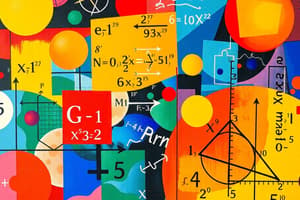Podcast
Questions and Answers
Which of the following is an example of an irrational number?
Which of the following is an example of an irrational number?
- π (correct)
- 7
- 0.5
- 2/3
What is the area of a triangle with a base of 10 units and a height of 5 units?
What is the area of a triangle with a base of 10 units and a height of 5 units?
- 15 square units
- 30 square units
- 50 square units
- 25 square units (correct)
Which operation follows the order of operations after parentheses in PEMDAS?
Which operation follows the order of operations after parentheses in PEMDAS?
- Division (correct)
- Addition
- Multiplication (correct)
- Subtraction
What is the derivative in calculus primarily used to measure?
What is the derivative in calculus primarily used to measure?
Which of the following describes a prime number?
Which of the following describes a prime number?
Calculate the volume of a cylinder with a radius of 3 units and a height of 5 units using the formula V = πr²h.
Calculate the volume of a cylinder with a radius of 3 units and a height of 5 units using the formula V = πr²h.
Which of the following is NOT a measure of central tendency?
Which of the following is NOT a measure of central tendency?
What is the fundamental theorem of calculus about?
What is the fundamental theorem of calculus about?
Flashcards are hidden until you start studying
Study Notes
Basic Concepts in Mathematics
-
Numbers
- Natural numbers: 1, 2, 3, ...
- Whole numbers: 0, 1, 2, 3, ...
- Integers: ..., -3, -2, -1, 0, 1, 2, 3, ...
- Rational numbers: Fractions and decimals (e.g., 1/2, 0.75)
- Irrational numbers: Non-repeating, non-terminating decimals (e.g., π, √2)
-
Arithmetic
- Basic operations: Addition, subtraction, multiplication, division
- Order of operations: Parentheses, Exponents, Multiplication/Division (left to right), Addition/Subtraction (left to right) - PEMDAS
-
Algebra
- Variables: Symbols that represent numbers (e.g., x, y)
- Expressions: Combinations of numbers and variables (e.g., 3x + 4)
- Equations: Statements that two expressions are equal (e.g., 2x + 3 = 7)
- Functions: A relationship that assigns a single output for each input (e.g., f(x) = 2x + 1)
-
Geometry
- Basic shapes: Circle, square, triangle, rectangle
- Area formulas:
- Square: A = side²
- Rectangle: A = length × width
- Triangle: A = (base × height) / 2
- Circle: A = πr²
- Volume formulas:
- Cube: V = side³
- Rectangular prism: V = length × width × height
- Cylinder: V = πr²h
-
Trigonometry
- Fundamental ratios: Sine (sin), Cosine (cos), Tangent (tan)
- Key identities:
- sin²θ + cos²θ = 1
- tanθ = sinθ / cosθ
- Pythagorean theorem: a² + b² = c² (for right triangles)
-
Statistics and Probability
- Measures of central tendency: Mean (average), Median (middle value), Mode (most frequent value)
- Probability: Likelihood of an event occurring, ranging from 0 (impossible) to 1 (certain)
- Fundamental counting principle: If one event can occur in m ways and another can occur independently in n ways, then the total number of ways the two events can occur is m × n.
-
Calculus
- Derivative: Measures the rate of change of a function.
- Integral: Measures the area under a curve.
- Fundamental theorem of calculus: Connects differentiation and integration.
-
Number Theory
- Prime numbers: Numbers greater than 1 that have no divisors other than 1 and themselves.
- Factors and multiples:
- Factor: A number that divides another without leaving a remainder
- Multiple: The product of a number and an integer
These foundational concepts serve as the basis for advanced mathematical study and applications in various fields.
Numbers
- Natural numbers, also known as counting numbers, start at 1 and continue infinitely – 1,2,3, and so on.
- Whole numbers include all natural numbers but also include zero – 0, 1, 2, 3, and so on.
- Integers are whole numbers and their negatives – … -3, -2, -1, 0, 1, 2, 3, …
- Rational numbers can be expressed as fractions or terminating or repeating decimals, like 1/2 or 0.75.
- Irrational numbers cannot be expressed as fractions and have decimal representations that are non-repeating and non-terminating, like pi (π) or the square root of 2.
Arithmetic Operations
- Addition combines numbers, subtraction finds the difference, multiplication involves repeated addition, and division separates a number into equal parts.
- The order of operations PEMDAS (Parentheses, Exponents, Multiplication/Division, Addition/Subtraction) dictates the sequence in which operations are performed, from left to right.
Algebra
- Variables, represented by letters like x or y, can stand in for any number.
- Expressions combine numbers and variables using operations, like 3x + 4.
- Equations establish equality between two expressions, like 2x + 3 = 7.
- Functions establish a relationship between input and output values, where each input corresponds to one unique output, like f(x) = 2x + 1.
Geometry
- Basic shapes include polygons like squares, triangles, and rectangles, as well as circles.
- Area is the amount of surface covered by a two-dimensional shape. There are formulas for calculating the area of various shapes, including squares (A = side²), rectangles (A = length × width), triangles (A = (base × height) / 2), and circles (A = πr²).
- Volume measures the amount of space occupied by a three-dimensional object. Common volume formulas include the cube (V = side³), rectangular prism (V = length × width × height), and cylinder (V = πr²h).
Trigonometry
- Fundamental ratios in trigonometry are sine (sin), cosine (cos), and tangent (tan), which relate angles and sides of right triangles.
- Key trigonometric identities, such as sin²θ + cos²θ = 1 and tanθ = sinθ / cosθ, help simplify calculations and solve problems.
- The Pythagorean theorem relates the lengths of the sides of a right triangle: a² + b² = c², where c is the hypotenuse.
Statistics and Probability
- Measures of central tendency help characterize a dataset based on its typical value: mean (average), median (middle value), and mode (most frequent value).
- Probability measures how likely an event is to occur, ranging from 0 (impossible) to 1 (certain).
- The fundamental counting principle calculates the total number of possible outcomes when multiple events occur independently: if one event has m possibilities and another has n possibilities, then there are m × n total possibilities.
Calculus
- Derivative measures the rate of change of a function at a specific point.
- Integral measures the area under a curve, representing the accumulation of a quantity.
- The fundamental theorem of calculus links derivatives and integrals, establishing a fundamental relationship in calculus.
Number Theory
- Prime numbers are integers greater than 1 divisible only by 1 and themselves.
- Factor is a number that divides another number without leaving a remainder.
- Multiple is the product of a number and an integer.
Studying That Suits You
Use AI to generate personalized quizzes and flashcards to suit your learning preferences.




